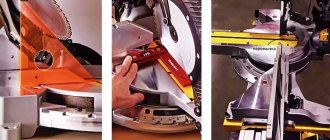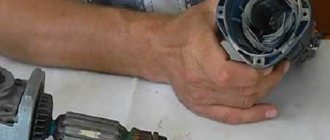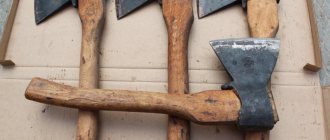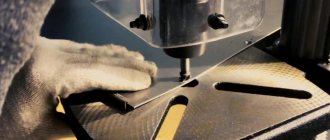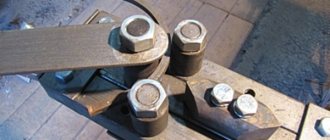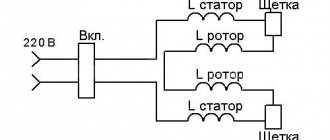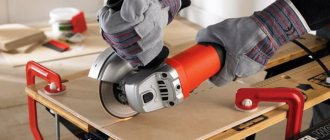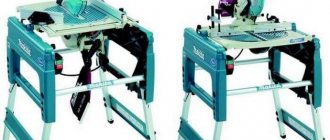Required tools and materials
When starting to manufacture a cutting machine, you should understand that the accuracy of its operation is directly related to the stability of the structure.
Therefore, the choice of a material of a certain thickness is dictated not so much by the requirements for the strength of the body, but by the need for its rigidity. Before you start working, you need to prepare:
- square profile pipe (25x25x2.5 mm);
- profile pipe “rectangle” (40x20x2.5 mm);
- metal sheet 4–5 mm thick;
- ball bearings No. 202, 203 or 204 – 2 pcs.;
- calibrated rod with a thickness equal to the diameter of the hole in the inner race of the bearing (up to 100 mm);
- rod with a diameter of 8–10 mm;
- metal tire (20x4 mm);
- bolts and nuts with M8 or M thread.
Tools you will need:
- Angle Grinder;
- drill or drilling machine, set of drills;
- a set of dies for cutting metric threads;
- open-end wrenches;
- welding machine.
To make a machine, it is better to choose an angle grinder from a well-known manufacturer.
The main component of the cutting machine is the angle grinder. It is not recommended to use a “small” grinder designed for cutting discs with a diameter of up to 125 mm and a power of up to 500–600 W. Remember that the larger the diameter of the cutting wheel, the more versatile and reliable the machine will be.
The careful selection of power tools is also due to the wide variety of angle grinder designs available on the market. Since such equipment is not unified, the cutting machine is built for a specific model and size of angle grinder. If the equipment is unreliable, then if it fails, it will be difficult to install another angle grinder in its place without the need to rework the mounts and pendulum. That is why it is better to choose products from trusted manufacturers - Makita, Bosch and so on.
A simple and reliable carriage (broach) for an angle grinder
List of materials:
— square pipes of small diameter;
— profile pipe 40X40 for the guide; — 8 bearings (used as rollers); — bolts and nuts; - a piece of round pipe; — 2 bearings for a hinge with a holder; - a few rods; - iron plates. List of materials:
- drilling machine; - Bulgarian; — measuring angle; - spanners; - band cutting machine or miter saw (optional); - welding machine; - paint for metal. Homemade manufacturing process:
Step one. Preparing pipes for the carriage frame
First, we need to cut 4 pieces of profile pipe, their length must be exactly the same. We also measure each piece of pipe with a ruler for curvature. We either straighten a curved pipe or do not use it, otherwise the carriage will not work correctly. Next, we mark the locations and drill holes; they should all be drilled at right angles and in clearly defined locations. The author uses a drilling machine for drilling. Holes are needed for bolts that will tighten the entire structure and on which the bearings will be located.
At the end, we paint all 4 pieces of pipe well with a spray can so that the structure does not rust.
Step two. Hinge
Let's make a hinge to which the handle with the angle grinder attached will be attached. There should also be no backlash in this unit. We use two ball bearings and press them into a housing made from a piece of pipe. The author cut the pipe lengthwise so that the pipe would tightly press the bearings. Between the bearings we place a bushing made of brass tube or other metal.
Step three. Carriage assembly
We assemble the carriage, here you will need bolts and nuts. As for the nuts, it is better to use those that have a plastic locking ring; such nuts will not unscrew themselves and the adjustment will not be lost.
Next, the carriage is adjusted on a profile square pipe measuring 40X40. However, you can completely adjust the carriage for a rectangular profile pipe. The most important thing is that the pipe is smooth, otherwise the cut will turn out crooked. You can also install a hinge unit on the prepared carriage axle; we clamp the bearings with a nut and washers.
Step four. Grinder holder
We make a reliable holder for an angle grinder; the author welded the bracket itself from iron plates. The fastener is attached in three places, it is screwed with two bolts, and the angle grinder is additionally secured with a metal clamp.
Step five. Assembly and testing
We assemble the carriage and fasten the profile pipe clearly horizontally. The homemade product is ready, the machine cuts perfectly, now it won’t be a problem to cut a sheet of metal straight. This is the end of the project, I hope you liked the homemade product and found useful thoughts for yourself. Good luck and creative inspiration if you decide to do this again. Don't forget to share your ideas and crafts with us!
Become the author of the site, publish your own articles, descriptions of homemade products and pay for the text. Read more here.
Milling machine
- with a movable angle grinder. In this case, the tool is securely attached in a vertical plane to a special frame, which allows you to move the grinder relative to the milled workpiece, which is fixed motionless;
- with a rigidly fixed angle grinder. With this design, the workpiece moves in the desired direction, and the grinder is motionless.
In both cases, you need to think through the design, purchase everything necessary for its assembly, and also buy a collet-type cutter holder or make it yourself from a hexagon. The picture shows a simple, quickly manufactured design of a milling cutter made from an angle grinder.
Protractor for grinder
By using such devices, you can easily calculate the cutting angles of workpieces. And this has a positive effect on the speed and quality of work performed. In addition, this device is suitable for cutting metal profiles.
- This type of design is widely in demand when working on wall and floor tiles.
- They are also used for cutting and processing flooring and baseboards.
By making a protractor for an angle grinder with your own hands, you will no longer need to purchase special tools, which are often expensive and large in size. A homemade protractor is not suitable for industrial use, but for home use it will be an excellent replacement for store-bought tools.
The operating principle of a homemade protractor design
install guide angle
Then you need to press the workpiece tightly against the shelves of the corner. After this, the user must set the cutting angle he needs.
Next, you can proceed to cutting the material.
When performing this action, it is necessary to take into account that when cutting it is necessary to press lightly on the disc. No serious physical effort required
A homemade protractor for an angle grinder has a design consisting of the following elements:
- Corner.
- Loops.
- Bolt used for fixation.
Note that making such elements with your own hands is quite difficult. Therefore, if you are not sure that you can cope with such a task, then it is better to purchase ready-made models of protractors in the store.
The grinder is a fairly popular tool among builders and repair specialists. It can be used to cut various materials and process workpieces and parts. However, sometimes specific operations are required. Therefore, experts purchase special attachments for the grinder. They can be found in stores without any problems.
The use of such devices allows you to expand the number of options for using this tool. However, it is not always necessary to buy them in hardware stores. If you wish, you can make them yourself. To do this, you just need to have free time and know how to properly make attachments for an angle grinder.
By following the recommendations of experts and completely following the instructions, anyone can make attachments for this tool, which will make the grinder a universal tool and make the work easier.
Types of devices, their advantages and disadvantages
There are two types of designs of cutting machines, differing in the location of the grinder, which can be made at home.
The first installation is a frame with an angle grinder rigidly fixed underneath it. Only the cutting disc is visible on the working surface, which fits freely into the table slot. Cutting a metal profile or sheet in this case is completely identical to cutting wooden blanks using a circular saw. Despite the very simple design, this scheme is not particularly popular. Those who have made such a device note that it is inconvenient to use due to the need to move the workpiece. This significantly reduces the accuracy of the work and makes the process unsafe. The only advantage of a machine with a bottom angle grinder is the ability to quickly cut thin metal sheets.
A cutting machine with a lower angle grinder can be used both for cutting metal and as a circular saw
The second scheme, in which the part remains stationary and the cutting wheel itself moves, is more convenient. The so-called pendulum saw, placed above the tabletop, allows you to cut the workpiece exactly at the required angle, and it becomes possible to make the required number of parts of the same type. Due to the location of the grinder on top, cutting workpieces does not require effort, and operation of the unit becomes simple and safe. The undoubted advantages of the design include the ability to quickly dismantle the grinder for traditional use. As for the disadvantages of this method, the weak link can be considered the hinge joint, which complicates the design of the machine.
A machine for cutting metal with an upper angle grinder has a more convenient design and makes it possible to cut workpieces at the desired angle
Materials and tools
The first question that a home craftsman faces when designing a stand for an angle grinder is what to make it from. The answer to this question is elementary: we will make what we have. If you have water pipes at hand, they will be useful for making hinges and guides. If there is a metal corner, we will assemble a frame from it.
The main and most complex component of a pendulum cutting saw is the hinge assembly. It bears the greatest loads, and the pendulum arm should not be able to deviate arbitrarily to the left or right. Please pay the greatest attention to the design of this unit. It is ideal to use roller bearings. Choose a couple of suitable sizes - and build the rest of the structure “around them”.
It is best to mount the pendulum arm on ball or roller bearings. This will ensure the best accuracy and rigidity. But if there are no suitable ready-made products, it is quite possible to look at options for homemade designs of this unit.
If there are no ready-made bearings, select pairs of metal tubes and steel pins of suitable diameters. This will allow you to make not very high-quality, but homemade bearings. For a “plywood” machine, good hanging hinges, used for fastening doors and gates, will work well as a suspension for the pendulum arm.
In any case, it is better to make the pendulum arm itself from a metal corner or a metal profile. But the holder in which the angle grinder will be fixed will probably be made of wooden beams.
For reliable and tight fixation of the grinder in the holder, it is better to cover the stock with soft and durable material. For example, leatherette. And it is most convenient to press the angle grinder to the holder with flexible metal ties with a screw assembly. These are widely used in plumbing and car service.
It is best to make the bed from a thick sheet of metal. Compromises are possible, up to thick plywood mounted on a frame made of wooden beams. It is good to provide on the work table the possibility of fastening the stop angles at some standard angles to the cutting axis. This way we get a “miter saw”.
Don’t forget that you won’t be able to control turning on the angle grinder on the machine in the usual way. We can replace the operator's hand on the control keys with the same screw ties for pipelines. But the key control station (which we will attach to the frame), a socket for connecting a fixed angle grinder to the circuit, and a wire with a plug of sufficient length to connect the entire machine to the network should be stored.
If we have metal blanks at our disposal, it is best to connect them by welding. If you do not have such an opportunity, it is better to turn to familiar masters of this business. Bolted connections become loose over time and negate all the advantages of a metal frame.
Of course, the grinder itself will come in handy when making the machine. Using it to cut blanks for a stand, you can feel like Munchausen, pulling yourself out of the swamp by your pigtail.
Bench grinder for grinder
Required equipment and materials:
- grinding device with an abrasive disc;
- racks (16 mm);
- a small piece of scrap (square or rectangle from 12 to 25 mm);
- plywood (6.5 mm);
- hand saw;
- drill with sorted drill bits;
- reciprocating saw or coping saw;
- optional, but highly recommended.
Step 1: Design. This model is designed for a cheap grinding machine. Think through all the details.
Grinding machine from grinder
- Step 2. Getting started. You will need a base and some support items to get your angle grinder up high enough to clear the wheel. Processing can be done using a hand saw.
- Step 3: Support. Mark and cut the 2 side supports, then forward and secure them with screws, pre-drill them (dimensions may vary).
- Step 4: Drill and Mount. Next, you need a bolt that fits the hole for the handle of your angle grinder.
- Step 5: Restoring the fixture. Now you need 2 sides. Where scrapers will make the circuit stronger, but if you don't have one, it will work without them.
- Step 6 Tongue. A tongue is a depression or groove in the edge of a piece of work material for attaching another board. There are several ways to add them. The easiest way would be with a table saw, but if you don't have one, another method is possible. Method 1: Mark where you want the tongue to be, clamp the piece and use a saw to carefully cut along the side of the line. If you want to make it easier, you can take a piece of wood and place it on the side of your line to make a barrier. You can continue making cuts along the side until you get to the end and then cut out what is left of the excess material.
- Step 7: Method 2. This method is much faster and more accurate if you have a router, you can make a small table for it.
- Step 8: Combine the elements. Now mount your 2 sides and measure the dimensions of the top of the product, cut out the required cover and install.
- Step 9: Strap. One bolt is not enough to hold an angle grinder. The bolt is subject to flow on it, so find some strapping material, duct tape. Such products will work if you have absolutely nothing. You can use a small strip of metal.
Materials and equipment for making attachments for an angle grinder
Angle grinder wheels and discs can be made from a number of materials. However, in general, a diamond blade will provide maximum precision and polish. Wheels are available in a range of abrasion (or sand) levels. Use a higher abrasion accessory for rougher polishing surfaces.
However, despite all this, many people still decide to create components for the grinders with their own hands. If you decide to create accessories for a working angle grinder yourself, then before starting work you need to prepare the necessary tools:
- An electric drill, preferably.
- Set of drills.
- Discs must be selected with a diameter of 125 mm.
- Wooden blanks.
- Metal corner.
- Steel plate.
- Self-tapping screws.
When it is necessary to use an angle grinder for specific tasks, in this case many craftsmen opt for ready-made applications. They can be bought without problems at a construction supermarket. The cost of the devices is not very expensive.
Do-it-yourself wall chaser from an angle grinder
A wall chaser made from an angle grinder allows you to do your own tracing on all building materials in absolute safety and in the absence of dust. This wall mount tool is very useful when you need to make cuts for installing piping, placing cables for electrical systems and for installing pipes for hydraulic systems.
The saw blade mounted on the shaft is the main element of the device. To ensure safety, the discs are mounted inside a special housing, which prevents fragmentation and personal access when sawing.
Do-it-yourself wall chaser from an angle grinder
Depending on the properties of the material and density, it is recommended to choose the motor power for a wall chaser made from an angle grinder with your own hands. A modest block is enough to furrow the cable. For a long groove for a pipe, it is advisable to purchase an angle grinder with a power of at least 2000 W. Some high-performance models are capable of achieving speeds of around 6200 rpm, which guarantees the ability to cope with industrial scale.
But the design of the grinder is such that it cannot be used due to the active formation of dust. They often resort to upgrading the device.
You can design a device with two disks. Installing a machine from a suitable angle grinder with your own hands of this type will cost more. The first disk is attached as usual, and the second is mounted. A second nut is required, which has an additional ring for fixation. When working on a wall, the sanding attachment must be in the protective cover.
Making a chain saw from a grinder
With your own hands, if you know how, it is not difficult to make a chain saw - this is a hand tool, and the grinder is used as a drive.
Due to the high revolutions, you can use a low-power angle grinder. The main element of this design is the tire. It must be secured so that the axis of movement of the saw chain coincides with the installed drive gear. Therefore, when making a bracket, you cannot do without a milling machine. Any slight deviation is fraught with tragic consequences.
Work order:
- The bracket is manufactured according to the drawing of the working version for a specific model.
- Two studs with nuts are screwed in to secure the tire.
- The bracket is fastened to the body in the mounting holes of the protective casing.
- A gear is put on the grinder shaft. It is secured with a clamping nut. The outer diameter of the nut is larger than the gear, which will prevent the chain from falling off.
- After the chain is put on, it is necessary to tension it and secure the bar with nuts.
Among the disadvantages of such a chain saw, it should be noted that it operates without lubrication, which leads to significant heating and rapid wear. The oil must be applied by hand. The absence of a brake allows the chain to still rotate for 30 seconds after removing the voltage from the electric motor. The small size of the grinder and the long tire affect the ergonomics of the design.
But it is still surprising that modern Kulibins are capable of making many devices from an ordinary angle grinder, the cost of which in stores reaches tens of thousands of rubles.
Cutting machine
A cutting machine is used for cutting and cutting metal and profiles, obtaining blanks of the same size, cutting to a certain depth, cutting ceramic tiles, etc. You can purchase a ready-made design in a retail chain, which costs a lot of money. You can make a device that will perform the same functions at home and small workshops from an angle grinder with a power of 0.9 kW or more.
The figure shows that to manufacture such a device, you only need to think through the design and reliable fixation of the angle grinder. To do this, you must first determine the dimensions and secure them in 2-3 points so that the tool does not move during the cutting process.
And this is very important
The grinder can also be located at the bottom of the table top. In this case, it will not only cut different materials into pieces, but also work as a circular saw.
What are the advantages and disadvantages of homemade machines made from grinders?
The homemade products in question have some advantages and disadvantages, which everyone who has set out to make a cutting machine from an angle grinder also needs to know about. The advantages include:
- Having a stationary machine in the garage, you can quickly, and most importantly, efficiently cut different materials
- Obtaining a high-quality and even cut, which makes the device perfect
- Cheap - if you have an angle grinder, then the cost of manufacturing the machine will be minimal
Now let’s find out what disadvantages the homemade device in question has:
- Low reliability - even with the most competent approach, the possibility cannot be ruled out that a person may receive various injuries just because of working on such homemade equipment. To protect yourself, you need to work in protective clothing
- The difficulty of transporting the device depends on its size and weight. Only if the machine is called stationary, then it is intended for use in only one place
If you have already managed to manufacture the type of equipment in question, then understanding the correct operation of it will not be difficult. Already from the first test of the tool you can feel how effective its work is. Below is a selection of photos showing options for homemade cutting machines from grinders. In addition, a tool such as an angle grinder is fraught with many interesting ideas for expanding functionality, but that’s a completely different story.
https://youtube.com/watch?v=BthXgs0WBbs%3F
Publications on the topic
How to use a grinder to make a circular saw
Making an ice screw from a screwdriver with simple instructions
We make roller shears ourselves from bearings
Making a lathe from a drill yourself
Wall chaser from an angle grinder
Using an angle grinder with a power of 1.2 kW or more, it is not difficult to make a device for making grooves (grooves) in the surfaces of walls, floors and ceilings. The main task is to install two disks on the shaft. After all, they are the ones who cut a groove of the same width and depth for laying cables, wires, and pipes of small diameter. The size of the original angle grinder shaft does not always allow them to be installed there, and even at a certain distance. In this case, you have to make bushings in order to secure the discs to them to the required size using spacers of different widths. Since the protective casing of the angle grinder is designed for one disc, there is a need to manufacture a new protective casing that would protect the worker during the operation. It often becomes necessary to equip such a protective casing with a pipe for removing dust and small waste to the vacuum cleaner. More advanced craftsmen install angle grinders on special rollers (from 2 to 4) in order to reduce the load on their hands while moving and move it effortlessly across the surface. It would not be superfluous to have a unit for adjusting the immersion of disks into the surface, the design of which also needs to be thought through.
When working with tools based on an angle grinder, it is necessary to observe safety precautions. Under certain circumstances, they can harm human health, cause injury and even death. Before starting work you must:
- wear protective clothing and personal protective equipment (mittens, safety glasses, dust mask, earplugs);
- check the reliability of fastening of all components of the device;
- check the integrity of the electrical cord and plug;
- make sure that the disk of the required diameter is installed, without flaws and suitable for the work being performed;
- Check the operation of the device at idle speed.
- make sure that the electrical cord is not twisted or pulled;
- do not remove waste while the grinder is working with your hands;
- the material to be processed must be securely fixed if this is provided for by the technology for performing the work;
- do not work with the device if there are signs of its malfunction;
- Replace the disk with a new one or a failed one only after its rotation has stopped.
Upon completion of work, the device must be disconnected from the electrical network.
In the video you can clearly see devices where the angle grinder is a mandatory element of the design. They will help home craftsmen facilitate the performance of many operations, increase the quality and productivity of labor, and expand the capabilities of the grinder.
Console machine from a grinder
The base of the machine is a work table made of metal (steel or aluminum), about 50x50 cm in size. If you are going to work with long workpieces or metal sheets from time to time, then the width of the table can be increased or the possibility of installing an additional plane can be provided. To do this, you can use a retractable bracket, or a folding plane, which is normally located under the table and serves as its base.
A bracket is mounted on the table for mounting the angle grinder on a spring suspension. The spring force is selected such that it can hold the grinder in an inclined position at a height of the cutting disc from the workpiece of at least 15 -20 cm. When cutting, the tool should be fed to the workpiece with a small but noticeable force.
The angle grinder is clamped in a box-shaped housing with screws. The dimensions and configuration of the pressure plates are selected in such a way that:
- easy access to the start button was provided;
- the tool was firmly held, and no beats or deviations occurred with the cutting force;
- installation and dismantling did not take much time.
Drawings of a homemade machine can be adjusted depending on the size and power of a particular tool
Only one thing is important here - that the tool is held firmly and the plane of rotation of the disk is strictly perpendicular to the plane of the table. On the table itself, in the zone of rotation of the circle, a slot is made so that the working part of the tool fits freely into it and does not touch the metal
The mounting option is a “U”-shaped bracket with drilled holes in place of the standard threaded sockets of the angle grinder. When attaching the tool, two bolts and a handle are used, which serves to feed it into the cutting zone. This option is very convenient if the machine is made for one angle grinder; if you have to use another model, it will be impossible to fix it, you will have to redo the bracket. A scheme with variable console dimensions is also quite workable, but more difficult to manufacture.
Miter box from a grinder
A miter box made from a grinder makes working with the device much easier.
Material:
- iron plate 1×200×100×2 mm;
- iron rod 2×150×30×3 mm;
- iron rod 2×40×30×3 mm;
- iron rod 2×30×30×3 mm;
- 1x8x80mm screws;
- 2x8mm nuts;
- 2×8 mm washers;
- screws 2 × 7 × 30 mm;
- screws 1×7×50 mm;
- 3x7mm nuts;
Miter box
How to do:
- Step 1: Create the base of the stand.
- Step 2: Preparing the material Adjust the dimensions of the metal plate 200×100×2 mm so that the sides are at right angles (90°);
- It is necessary to cut 2 pieces of iron beam 40×30×3 mm;
- Mark the center and drill a 10mm hole on one side. The hole should have a diameter of 7 mm;
- Cut two pieces of iron 150 mm;
- These blanks require 3 holes. The hole must be located 10 mm from the edge;
- The holes must match the bolts;
- The rods must be molded according to the grinder to fit the profile of the machine;
- Cut one piece of 30mm iron rod. Drill a hole with a diameter of 7 mm.
- Then screw these parts into the machine and adjust them. One will be fixed in the right side hole and the other will be fixed in the top hole;
At this stage it is important that the final part is at a right angle
- Step 4: Base Take 2 pieces of 40x30x3mm iron bars and place them on the sides on both sides and replace the screw to connect them and make soldering easier.
- Place the attached set of brackets and sides on the plate so that it is more offset to the right. There should be a slight difference on both sides.
- Then you need to weld the elements of the device (give only one soldering point) on both sides. Make any necessary adjustments. There should be no excessive displacement.
- To facilitate movement, two washers are cleverly installed between the side and the handles.
- After checking alignment, perform final welding.
Step 5: Completing Assembly Observe whether you move freely and the angle can reach - 90º. After checking alignment, perform final welding.
Step 6: Processing the base. Mark the cut. Start by gluing the corners and trim using a saw. Step 7: Base with sander installed. Take advantage of the handle support that already accompanies the hardware and replace the originally installed screw. Step 8: Screw Depth Hole. Screw allows you to adjust the depth of the cut
Pay attention to the alignment of the disc in the longitudinal and transverse directions. Step 9: Reminder. Please remember that these instructions are for an angle grinder with three factory holes.
This made it possible to fix the machine in the support, and the third hole regulates the cutting depth during operation.
Pendulum saw
- Step 1: Create the Angle Grinder Bracket. You can use the threaded holes in the angle grinders as support points for the bracket. There are many ways to approach creating a handle, depending on the type of grinder you decide to work with. Critical measurements are necessary to compose a functional design that allows the grinder to be easily separated for manual work. Five pieces of flat metal rod were required to assemble the device. Welding them together created a custom bracket. It is necessary to weld a short piece of reinforcement as a rod to attach the wooden handle.
- Step 2: Create a clamp that will hold the sanding head handle firmly against the head of the adjustment bolt.
- Step 3: Next, you need to attach the leg to the front end of the rods to secure the angle grinder arm, enabling the hinge feature that allows the sander to pivot to the cutting table.
- Stage 4: Creating the Foundation. It is possible to use a simple frame using tubes and mounting them with two pieces of iron. It is necessary to form a flat platform for attaching the slider mechanism.
- Stage 5: Assembly.
- Step 6: Adding a cutting table. The cutting table consists of a steel plate. After all parts are assembled and adjusted, level the vertical surface of the cutting wheel.
- Stage 7: Final testing.
Pendulum saw
Pendulum saw + (Video)
It’s not difficult to make accessories for an angle grinder with your own hands. You don't even need drawings here. It is enough to know the principle that is embedded in a particular machine. A pendulum saw based on a grinder is no exception. This is the same cutting machine, but its weight is distributed almost in half.
It is somewhat similar to a children's swing. A frame is located on a movable bushing, and an angle grinder is mounted on it. The counterweight can be any weight in combination with a return spring.
TOP 6 drawings will help you make a cutting machine from an angle grinder with your own hands without errors and extra costs. Answers to frequently asked questions, recommendations.
- What switches are installed for emergency stop of the machine?
b) hand and foot.
- Which angle grinders are suitable for creating a cutting machine?
a) pneumatic and electric;
- Minimum power of the electric motor of an angle grinder for a cutting machine from an angle grinder:
- What machines can be made based on angle grinders?
a) trimming, cutting;
b) grinding, milling, sharpening.
- Where can you place the grinder in the cutting machine?
a) above the tabletop;
b) under the tabletop.
- The correct option is b). Foot switches are more convenient because they operate quickly.
- Theoretically, there is enough power in all three options. In practice, a) - electric and pneumatic models are used. A battery is not needed for a stationary machine. For a pneumatic drive, you will have to purchase a compressor of appropriate capacity.
- 900 W or more. Correction is made if workpieces made of relatively soft materials are expected to be processed, or at high speed.
- Both options are correct. A powerful grinder is suitable for creating various machines at the household and semi-professional level.
- Two mounting options are allowed. Experts prefer the top one.
An electric grinder performs many different work operations. To reduce labor costs while increasing accuracy, it is used as the basis for the machine.
“Bulgarian” is a common name for an angle grinder (angle grinder). By changing the disk, this universal device can be converted for cutting and performing other work operations.
To make a cutting machine, you will need the following materials:
- profile pipe 40 x 20 mm – 0.32 m;
- profile pipe 20 x 20 mm – 1.38 m;
- profile pipe 15 x 15 mm – 0.34 m;
- strip 40 mm – 0.14 m;
- strip 20 mm – 0.16 m;
- bearings 100 series – 16 pcs.;
- M10 bolts for hexagon 75 mm – 8 pcs;
- nuts M10 – 12 pcs;
- washers 10 mm – 32 pcs;
- long nuts M12 – 3 pcs.;
- long nut M10;
- M12 bolt with full thread 200 mm;
- bolts M10 40 mm – 2 pcs.;
- 70mm full thread hex bolt;
- plugs for profile 20 x 20 mm – 6 pcs;
- plugs for profile 40 x 20 mm – 1 piece;
- profile pipe 50 x 50 mm, for a guide – 2 m or more.
The following photo shows the process of making a homemade product.
First of all, let's make a roller carriage for the linear guide. A profile pipe with a cross section of 20 x 20 mm will be used as its basis. You will need 4 blanks 300 mm long.
Then, in the workpieces, you need to drill through holes for the future connection of parts. Their centers are located 25 mm from each edge of the profile pipes. You will need a drill with a diameter of 11 mm.
We turn the coated profile over to the other side, and having retreated 50 mm, we drill similar through holes on each side. To hide the bolts used later when assembling the carriage, the through holes in the workpieces need to be completed. To do this, one wall of each profile needs to be drilled using a drill with a diameter of 17 mm. In this way, all 16 holes are completed, the remaining 16 adjacent to them remain untouched.
Let's make a shoulder for attaching the grinder, cut a profile 40 x 20 mm, 300 mm long.
You will also need to make a knot to adjust the cutting depth when cutting. It is made from a profile pipe 20 x 20 mm, 160 mm long. Its ends are cut at an angle of 45 degrees. From a profile pipe with a cross-section of 15 x 15 mm, you need to cut small spacers 40 mm long. A total of 8 pieces are required.
We assemble the structure. An M12 bolt with a solid thread 200 mm long will be used as a connecting loop. 3 long M12 nuts are screwed onto it. Having secured the bolts with nuts with clamps to the table, you need to attach blanks from a pair of profiles 20x20 mm, and one 40 x 20 mm. The pipes must be welded to the nuts.
Then, from a strip 40 mm wide, you need to cut 2 pieces 50 mm long. In the center, closer to the edges, we drill a hole with an 11 mm drill.
These plates will serve to fasten the grinder into the standard holes used to attach the handle. In some tools, these holes can be made for M8 bolts, which will need to be taken into account. For reliability, the M10 40 mm clamping bolts must be equipped with nuts. The bolts are screwed into the gearbox through the plates and tightened with nuts.
Now, stepping back a little from the fastening of the plates, the previously made workpiece from a 20x20 profile with a length of 160 mm is boiled down. A plug is welded onto its free end from the same strip as the mount for the grinder. A hole is drilled on the protruding ear of the plate, and an M10 nut is welded onto it. To strengthen the structure, an additional steel strip 160 mm long, also sawn at 45 degrees, must be welded onto the side of the profile.
After painting the parts, we assemble the carriage. To do this, you will need M10 hex screws 75 mm long. It is necessary to tighten the 20 x 20 mm profile pipe blanks together. At the same time, a pie is formed between them: washer, bearing, washer, spacer, washer, bearing, washer. By repeating this 7 more times, the result is a finished carriage.
Assembling the mount for the grinder.
On the table, install the guide and roller carriage. Its height is adjusted by lining it with wooden blocks. The tool is attached to the edge of the table. The workpieces for cutting are pressed with a pair of metalwork clamps. For convenience, you can carry out cutting in several passes, each time adding the depth of the cut.
Homemade cutting machine from a grinder, ready for work.
The machine makes smooth and precise cuts.
The result is a convenient cutting machine for metal.
We also recommend watching a video that shows the process of making a cutting machine from an angle grinder and testing it.
Models of metal cutting machines
The equipment sold is equipped with a rotating tabletop for cutting at different angles. Homemade products are made in two versions: rotating at an angle of 45° and non-rotating. For each option, you can find do-it-yourself drawings of a cutting machine from an angle grinder with full detail on the Internet.
Rotating device
To manufacture this version of the machine you will need:
- angle grinder;
- steel angle 50 and 40;
- pipe for water supply with nominal diameter DN32 and 25;
- profile pipe 15x15, 20x20; 25x25;
- steel sheet 4 mm thick;
- closed or semi-closed radial bearings 202 - 2 pieces, thrust bearing 8102;
- M14 pin;
- hardware M6, M8 and M14;
- doorstop;
- tin or galvanized.
Manufacturing procedure:
- Cut two pieces from the 50th corner.
- Drill holes in them. Hole diameter 14 mm.
- Attach the resulting parts to the angle grinder with bolts to the places where the handles are attached.
- In this position, weld the corners in two places. Then, unscrew it from the grinder and finally boil it.
- To make the carriage, you need to cut a piece from the DN32 pipe.
- From the DN25 pipe, cut a piece shorter in length by the height of two bearings.
- Press one 202 bearing into the DN32 pipe.
- Insert a length of DN25 into it.
- Hammer the second bearing.
- Connect the welded corners and the carriage with an M14 hairpin.
- For reliability, the racks are made from 50-gauge angle. To obtain the same size of both parts, they must be tightened with clamps. In this condition, holes should be drilled.
- The stands are screwed to the carriage.
- From a 20x20 profile pipe, cut two rods of optimal length and a handle.
- For the base, a sheet of 4 mm and size 600x600 mm is sufficient.
- Weld the structure.
- Cut a groove in the sheet for the circle to come out.
- Secure the return spring.
- A vice-type clamp can be made from a stud of a piece of 20x20 pipe and nuts. The nuts are welded to the base. The pin, rotating, moves the pipe forward, clamping.
- For ease of rotation, you can make a handwheel by welding a long bolt.
- The casing is made according to a template. Two mirror patterns.
- The frame is cut from a corner to which the patterns are secured with M6 screws.
- The casing is attached to standard holes.
- For mounting on a workbench, two holes are drilled in the base for M8 bolts.
The result was a fairly compact design with pipe clamping, spark protection and a flat base surface.
Fixed option
Unlike the first model, this design is more technically complex .
It has an ear wheel reach adjustment. She received this opportunity due to the use of car racks of the car. Due to the thin frame of the struts , brackets are required into which shock absorbers are inserted . The diameter of the pipe is selected for specific shock absorbers. The do-it-yourself frame for an angle grinder, the drawings of which are presented, is made from a corner. The remaining blanks are manufactured according to the drawings.
Welding of the structure should be done semi-automatically. The height of the seam is minimal, and there is no need for further cleaning. To facilitate movement, the mechanism is assembled on bearings. This eliminates backlash and jamming. The lifting height of the angle grinder is limited by the crossbar and the pin. By unscrewing the nut, the shock absorbers lift the mechanism upward. This ensures the use of different models of angle grinders.
For sawing pipes at an angle, the structure is equipped with a rotary table. The rigid mounting of the pipe cutter ensures an accurate cut, and the required angle is provided by the rotating mechanism, which must be secured in the desired position.
As you can see, you can make a disc cutting machine for metal with your own hands without using a lathe or milling machine.
Stand for grinder
No matter how skilled a craftsman is, he needs the perfect tools to get the job done. The angle grinder stand is provided as an excellent accessory for perfecting these corner pieces.
DIY stand for an angle grinder
The grinder stand allows you to grind at perfect angles of 115 mm-125 mm. If the stand is made of aluminum alloy, this allows you to have a device that will undoubtedly last a long time.
Get more out of your angle grinder with a convenient holder. Angle grinders are dangerous devices. Homemade grinder tools will allow you to have more control over them, but we still need to use all the necessary safety equipment, such as safety glasses and gloves.
What you will need:
- Woodworking accessories.
- A piece of hard plywood 300×100×20 mm.
- A piece of hard plywood 150x100x20 mm.
- 1 M12 screw, 30 mm long.
- 2 M12 washers.
Holder for grinder
The design is very simple, you only need to form a part 150X100X20, adapt it to the shape of the grinder.
Stand for grinder + (Video)
This device is a small machine with which you can easily, safely and very accurately cut metal pipes, profiles or rods. It consists of a base or small table attached to the ground or to a metalworking table.
The machine is assembled in a simple sequence:
- install a hinge on the base;
- We weld the supporting pipe to the hinge;
- We attach the U-shaped plate for attaching the grinder to the pipe;
- We put a rubber handle on the supporting pipe;
- install the disk and check its position.
As a result of some simple work, we got a machine or stand for an angle grinder. Now the grinder can rise and fall down on a hinge onto the part installed for cutting. In order for the angle grinder to rise up without loads, we install a spring on the pipe.
It is necessary to install two fixing angles on the table. At the base of one corner we make a groove around the circumference for a bolt. It will be needed when a pipe or profile needs to be cut at a certain angle. Then we install this corner with a slot at the same angle to the plane of the grinder’s cutting disc.
Parallel to the corner with the arc slot, we install a corner that can be moved towards the part to fix it on the table. The pipe or profile will simply be inserted between two corners. This is enough to perform fast and precise cuts.
By installing a supporting transverse metal bar on the machine table, you can strip the material using a steel brush mounted on the angle grinder shaft.
Making your own devices
To make working on an angle grinder easier, all sorts of designs have been invented that increase its functions. The presence of equipment makes it possible to use angle grinders as a belt grinding machine. It is not difficult to make accessories for an angle grinder with your own hands, and it will also cost much less.
Accessories for grinders
- Tripod
- Retainer
- Fraser
- Miter box
- Wall chaser
- Extension
A tripod is a device that frees one hand. The angle grinder is held with only one hand, and with the other hand it is possible to support the metal and turn it if necessary. In addition, it makes it easy to set the desired cutting angle. It allows you to do work efficiently and safely. The frame is made of metal profiles, a shock absorber, and sometimes even plywood is used. Such an improvement is only permissible for a machine with 125 mm discs; with a larger size it is dangerous, since you have to remove the casing. You can take different options as a basis or make your own drawing. The main thing is that the tool is securely fastened. The most convenient way is when the angle grinder is attached to the protection casing. You only need 2 10mm bolts and 2 nuts, which are attached to the outer part of the casing. There are 2 more plates and a pipe onto which everything is screwed. And the switch should be made not fixed, you can use a foot pedal, then in an unusual situation it is easy to stop the machine. If the design for cutting metal is strong, then you can use it for sawing wood.
Clamp – there are many clamps, but the best option for fastening an angle grinder is a vice. They hold firmly and there is no need to support with your hand, thereby reducing the risk of injury. Rotary vice increases the capabilities of the machine (oblique cut). When you install the desired disk or file in a vice, you get a sharpening machine, but after unscrewing it, you can do the work manually. And by attaching stops with a slot across the disk, very precise processing can be achieved. The most popular option is a band sawmill made from an angle grinder. You just need to have a reliable frame and strengthen the machine well.
A milling cutter is another device for an angle grinder. The machine has a powerful engine, so it can be converted into a milling cutter. To do this, you should take the shaft into the opening of the workbench and put a chuck with heads for milling on top. The resulting homemade device for an angle grinder is used to process hard wood.
It is important to remember that the device is not designed for this type of work, so you need to take care of your safety.
A miter box is a rotating surface for a grinding machine. Using this device, it is easy to cut plinths, baguettes, profiles at the desired angle
You just need to install the desired disk, then the surface is fixed at an angle of 45 degrees, and the machine is ready for work. You can cut any platband for a wooden house or paving slabs.
A wall chaser is a necessary device for an angle grinder. Used for laying wiring by hollowing out recesses in the wall. However, this is not safe. When making an attachment for an angle grinder that works on a dense base, it can be used to cut walls along the entire diameter of the disk. With a good sole for an angle grinder, its guiding movement is carried out smoothly, without much effort.
Extension cord – used for plumbing and plumbing work in hard-to-reach places.
A simple attachment for an angle grinder for an even cut
Have a good time everyone. Today, the hero of our article, he is also the author of the “Mens Craft” channel, Dmitry, will show us how he made a simple, but at the same time useful device for an angle grinder. Using this homemade product, it is much simpler and easier to cut straight metal, and by the way, you can cut not only metal, but also any other material, just install a suitable cutting wheel on the angle grinder.
TOOLS and MATERIALS: Marker; Square; angle grinder; Circles: cutting and petal; Welding machine; Electrodes; Electric drill; Drill; Sheet metal; Vise; Hammer; Hairpin, approximately M-10; Nuts M-10; Magnetic square; Bolts and washers for attaching the homemade product to the angle grinder; File;
First, the author cut two strips of the same size from sheet metal.
Then I made markings on them. As in the photo. Then I made holes in the marked place. First with a small drill.
And then big.
Like this. Next, the author clamped these blanks in a vice and, using a hammer, bent them a little. Like that.
Then marking again.
And removing unnecessary things.
Next, the author will weld the stud to one of the blanks.
Afterwards the welding seam will be processed. This is the detail we got. The master will install this part on the angle grinder and secure it with a bolt.
On the second side of the angle grinder, the author will install the second part and also secure it with a bolt.
Afterwards, the second part will also be welded to the stud.
And he will process the seam. Then, leaving small edges of the pin, cut off the excess. This is the detail.
Then the technician will install one nut on each edge of the stud. And put this detail aside.
And he will start making another part, his homemade product. To do this, he will cut a piece from the sheet metal.
Round off two edges on it.
Make the markings as shown in the photo. Next, slightly bend the edge with rounded corners.
Like this.
Then make a couple of holes in the marked places.
And then it will remove the excess.
Process the cut with a file. The second part is ready (Sole). Then the craftsman will install the previously made part onto the sole.
And holding the parts with a magnetic square.
I welded the nuts to the sole.
The author also welded another nut in this place for attaching an additional handle. Here is the finished device. The master installed the homemade product on the angle grinder. And fixed it with bolts. Like this.
Then I installed an additional handle.
And he began the test.
The result is on metal.
On plywood.
The sole of the device moves freely, for the author this is not important. (But the master says that if desired, it can be fixed or even made so that the depth of the cut can be adjusted.) Our hero turned out such a useful homemade product today. For which I thank him very much.
And that's all for me. Thank you all and see you again!
Source
This post may contain affiliate links. This means I earn a small commission from links used at no additional cost to you. See my privacy policy for more information.
device, angle grinder
How to make a frame for an angle grinder
It is obvious to everyone that it is extremely difficult to hold a heavy instrument for several hours. Therefore, to facilitate their work when performing an operation, many craftsmen make special devices called beds. When an angle grinder is equipped with such a device, cutting work can be done using only one hand.
To make a frame, you first need to make a wooden box. You can get by with only one side on which the tool will be attached. All other walls can be removed, and legs of a special design can be attached instead.
But in order to achieve the effectiveness of using an angle grinder with such a device, it is necessary to make some changes to its design.
The first step is to dismantle the casing of the angle grinder. After this, you need to put a disk on the instrument. When this action is completed, it must be pressed against the side wall of the device.
It is necessary to mark where the gap was made for the movement of the nozzle or disk. Its width should not be too large, otherwise foreign objects may get inside the structure during work.
If desired, the gap can be increased. The need for this arises in cases where it is necessary to replace the nozzles without completely disassembling the entire structure. Samples of wooden blocks can be used as support elements. After this, you can begin cutting workpieces.
Scope of application of cutting machines
Cutting disc machines are widely used in metalworking, mechanical engineering, woodworking and furniture industries. The units have also found their application in the household: they are used as a convenient tool for performing various tasks in the workshop and garage. The cutting machine is convenient to use to solve a number of problems:
- dividing the metal profile into segments of the required length;
- cutting sheet metal;
- obtaining a large number of similar blanks in a short time;
- cutting ceramic tiles;
- cutting parts at any angle, obtaining cuts of the required length, depth, and so on.
Due to their relatively low cost, universal units have a quick payback period, so they are profitable to use in small industries and small workshops.
In the household, a cutting machine is used irregularly, so purchasing a factory-made tool is irrational. It is better to make a special stand for an angle grinder. This will increase the versatility of the grinder, turning it into a small-sized cutting machine.
Making a stand for an angle grinder with your own hands
Angle grinders (angle grinders) are an indispensable hand tool. With their help you can saw, grind, cut almost any materials from wood to stone. But tasks often arise that require the use of machine tools.
For example, when cutting pipes, profiles or metal profiles, the task of cutting a long string into pieces of a certain length is quite common. In this case, it is important that the ends of the segments are strictly perpendicular to the center line.
When cutting ceramic tiles or bricks, it is even more difficult to maintain the perpendicularity of the cut while holding the grinder manually. When cutting thin and viscous material, the slightest deviation of the tool from the cut line can lead to jamming and breakage of the tool.
In such situations, it is quite natural to want not to buy a separate machine - this, as a rule, is not economically feasible.
You can expand the scope of use of your favorite hand tool by firmly securing it in some way.
Work technology
triangle shaped cutout
Next, six holes should be drilled in the plate structure. The diameter of each of them should be 4 mm. Subsequently, it is in these holes that the self-tapping screws will be installed. With their help it will be possible to fix the handle, corners and timber. All holes must have special recesses for screw heads.
To securely fasten the beam handle, a few self-tapping screws are enough. The fasteners used during this work must have dimensions of 3x35 mm. This will result in an L-shaped part.
After this, all the elements together with the plate are assembled into a single structure. The created tool fixture must be secured using 3x20 mm self-tapping screws.
So, the basis of the future structure has been made. Next, you will need to install metal corners. You should have several of these items available. They must have the following dimensions:
- 75x30x55 mm;
- 45x60x60 mm.
Please note that the first corner must be bent to 60 degrees. If you don’t do this, then you won’t be able to achieve your main goal - to attach the manufactured structure to the angle grinder.
When the installation of the metal corners is completed, the tool itself is attached directly to them.
To connect the tool and structural elements, use a separate handle on one side, and bolts with nuts on the other side. The latter are necessary so that during work the screw of the structure does not unscrew.
If desired, you can refuse to install the nut on the handle, since it will be held by the hand of the master during work. At this point, the work on creating a cutting structure can be considered complete.

